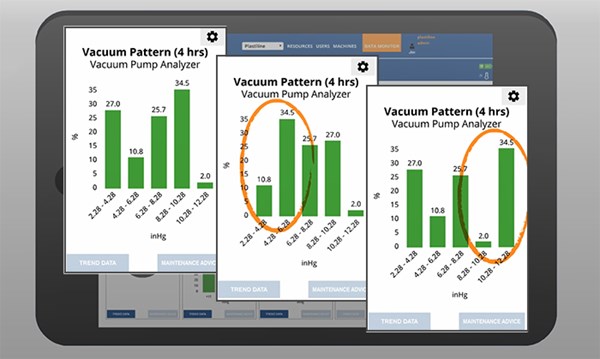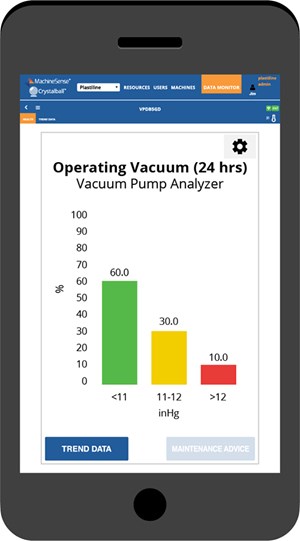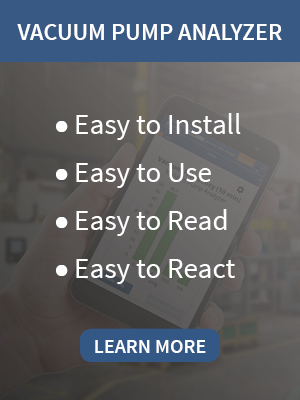Head Off Vacuum Pump Problems Before They Occur
Sponsored ContentPlastics vacuum conveying pumps often fail as a result of poor maintenance. With the pumps out of sight, and out of mind, it’s easy to miss the telltale signs of trouble. Here’s how inexpensive, constant monitoring can head off problems before they occur.
Share
There’s never a good time for a vacuum conveying pump to fail. It shuts down your essential processes, forcing emergency repairs or rerouting material, which is time-consuming, expensive and delays customer shipments.
Too often, the problem occurs at the beginning of the process—with the vacuum pump. Most pump failures can be easily prevented with basic maintenance. But vacuum pumps and blowers are usually located in hard-to-reach places and, frankly, are easy to forget. Some plants employ regularly scheduled maintenance…whether the equipment needs it or not. You’re left with wasted effort on unnecessary maintenance or unexpected downtime because of not enough.

How to Balance the Right Amount of Maintenance
The Vacuum Pump Analyzer from MachineSense is the answer. With new advanced monitoring and proprietary predictive technology, MachineSense Vacuum Pump Analyzer can tell you when the pump needs maintenance. Better yet, the system can also tell you what to do.
By connecting sensors on the equipment to cloud-based analysis software, the retrofitted Vacuum Pump Analyzer allows 24/7 monitoring of pumps and blowers that detects non-conforming operating conditions, identifies root causes and suggests likely remedies. Armed with this knowledge, maintenance technicians can identify emerging problems well before they turn catastrophic, and then schedule maintenance at the most convenient time.
Monitor the Conditions that Matter
Over 60% of all vacuum pump and blower failures are simply a result of poor oil and filter maintenance. These and other equipment problems typically reveal themselves in easy-to-sense conditions such as vibration, heat and pressure.
While easily detectable, technicians have long gone without a way to automatically monitor and diagnose these problems remotely. The Vacuum Pump Analyzer does this with easy-to-set-up sensors that stream the data to powerful cloud-based analysis software. This enables the system to automatically identify when equipment is in good working order, and when it is trending toward a condition that requires maintenance.

The pump analyzer monitors plastics conveying vacuum pumps,
transmitting data 24/7 to cloud-based analysis software.
How it Works
Vacuum Pump Analyzer sensors are attached to pump or blower housings to constantly measure vibration and temperature, and to the conveyor supply line to measure system pressure. The sensor data is collected by a data hub and is then sent via router to cloud-based servers running the MachineSense Crystalball analysis software.
The analytics software is the key. Besides collecting and presenting data in real time, it compares current readings against a baseline to determine overall pump or blower health, indicating filter status, oil status, pump/blower utilization, and conveyor line pressure trends.

Operating vacuum and frequency dashboards provide a complete understanding of overall conveying performance over time. In the example above, the vacuum pattern dashboard (left) shows normal operating patterns over a four-hour period. A subsequent reading (middle) shows the pattern has shifted, showing less idle time. That probably indicates the user should check the material supply or check for leaks in the lines. On the next dashboard (right), abnormally high vacuum pressure is shown, which can indicate a filter clog or insufficient material being pulled into the system.

Some dashboards indicate issues with individual components. For example, the Blower Health dashboard indicates the condition of drive belts and bearings. Other dashboards constantly monitor attributes such oil level and condition, filter status, pump utilization, operating vacuum pressure and frequency, and more.
Because all system performance indicators are constantly being compared against ideal baseline parameters, the dashboards can instantly convey when the system or component is trending out of conformance. The dashboard demonstrates when settings are adequate (green), when there is a warning (yellow), and when immediate attention is required (red).
The color-coded dashboards provide critical, easy-to-understand information at a glance and can be accessed on any internet-enabled devices including desktops, laptops, tablets and phones. Moreover, alerts can be set up for any conditions that stray out of conformance from preset parameters. That means maintenance technicians no longer need to check equipment on an arbitrary schedule. Nor will they be blindsided by problems that could have been caught earlier if only a technician were aware.
Implementing a Vacuum Pump Monitoring System

Vacuum Pump Analyzer is designed to be retrofitted for most vacuum pump brands in the plastics industry including Conair, Una-Dyn, AEC, Wittmann and others, allowing you to integrate the system into your existing operation easily and inexpensively.
Setting up the system is an added bonus. Installation is complete in under 30 minutes with just four simple steps:
- Place the sensor on the vacuum pump or blower,
- Attach the pressure sensor,
- Connect the sensors to the data hub,
- Register and sign in to the monitoring software.
The software will confirm that the sensors have been installed properly. To establish starting baseline levels, just optimize the pump oil level, clean the filter and check the belt for tightness. Vacuum Pump Analyzer will do the rest.
Pump equipment failure is a high enough cost to pay. Those who can afford it try to compensate with expert technicians and frequent maintenance.
With the Vacuum Pump Analyzer, a retrofit kit capable of monitoring two pumps with a single data hub costs $999, a valuable alternative considering costs that trickle well into the thousands. The package includes six months of the Vacuum Pump data plan, which costs $15 per month thereafter.
Ultimately, preventing even a single vacuum conveyor system failure, let alone the excessive costs of routine maintenance, enables the system to pay for itself and put the user at ease.
For more information on the Vacuum Pump Analyzer, visit MachineSense.com.




